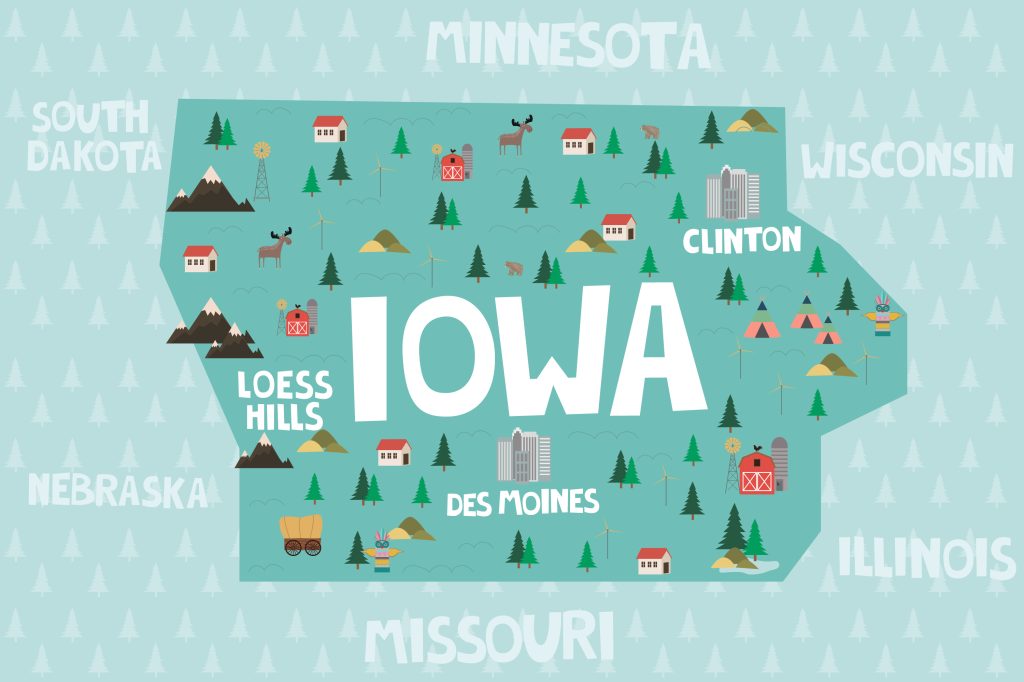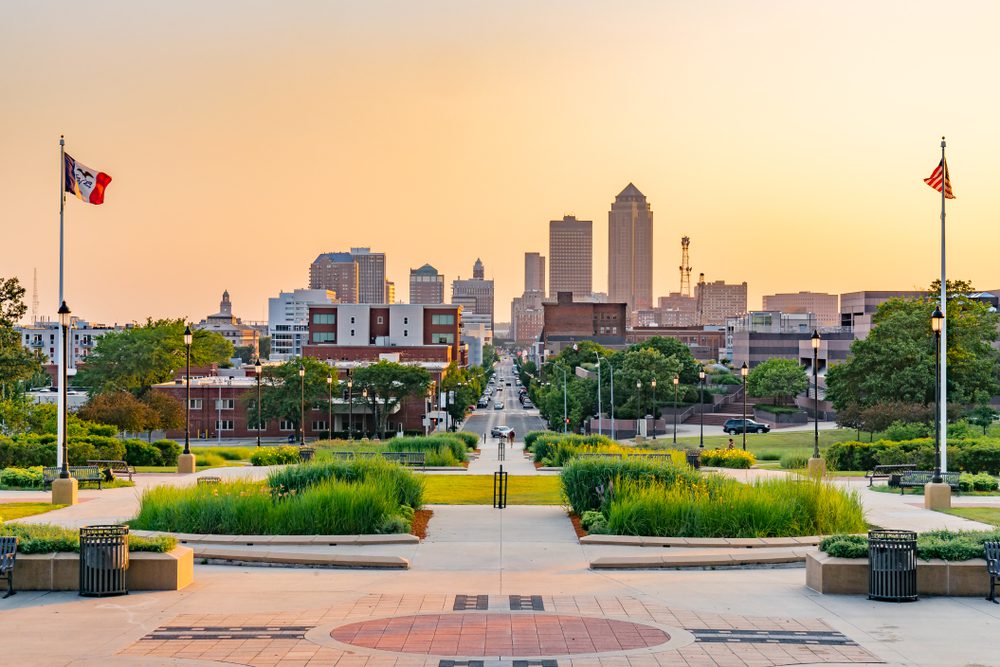
Iowa is a Midwestern state. It is bordered on the east by the Mississippi River and both the Big Sioux River and the Missouri River to the west.
It is also surrounded by six other states: Minnesota, Wisconsin, Illinois, Missouri, Nebraska, and South Dakota. It is completely landlocked and shares no borders with another country.

Where is Iowa on a US map?

On a US map with no states labeled, finding Iowa is easiest by finding the three rivers that create Iowa’s borders to the east and west. Even with state lines labeled, this may be helpful.
Iowa is in the middle of six other states in the Midwestern region of the United States. It is directly underneath Minnesota and directly above Missouri.
Interesting Facts about Iowa
Because Iowa used to be a part of French Louisiana, its state flag is similar to the French flag.
Iowa is one of the safest US states to live in.
It is the only state who has an eastern and a western border created entirely by rivers. The Mississippi River to the east defines the natural border between Iowa and the states of Wisconsin and Illinois.
To the Northwest, the Big Sioux River creates much of the border between Iowa and South Dakota. Then, the Big Sioux joins the Missouri River, and thus the border between Iowa and Nebraska to the west.
The Omaha, Nebraska, metropolitan area is so large that it extends into three different counties in the southwest portion of Iowa.
Iowa is nicknamed the Hawkeye state, after the highest point of elevation: Hawkeye Point. Hawkeye Point features a flagpole, some picnic benches, a mosaic and some granite markers to enjoy. It is 509 miles or 1,671 feet high.
Iowa was initially French, then it was Spanish, then it was French again for three weeks before the French sold the region to the United States in the Louisiana Purchase.
Iowa’s Capital City

Des Moines is the capital of Iowa. It is also the most populous city in the state. The city is notably in two different counties. Much of the city is in Polk county, but some of it is in Warren County.
Des Moines was initially named Fort Des Moines, but the name was later shortened to not include “Fort.” The Des Moines River runs through the city. The River was originally named the Riviere des Moines by the French, which meant “River of the Monks.”
Des Moines is important politically because it is the site of the first caucuses of the presidential race. For many people trying to get a start in politics, Des Moines may very well be the place to do so.
Des Moines is also home to the John and Mary Pappajohn Sculpture Park. There, visitors can meander around oversized sculptures. It is a park that is actually better at night, when the lights are illuminating the sculptures, creating fantastic contrasts of shadows.
The Iowa State Fair also takes place in Des Moines towards the end of summer. The fair has midway rides, live music, contests, and a Sky Glider.
Reasons to Visit Iowa
Iowa has plenty to do outdoors beyond the corn fields. Big Spirit Lake and Okoboji lake are popular spots for fishing, carnivals, swimming, and glass-bottom boat tours.

The Great River Road National Scenic Byway is 325 miles worth of scenic views along rivers, lakes, and through cities.
The Maquoketa Caves are a great place to explore a snapshot of an older time.

Ledges State Park has a lot of great camping sites and even some day trip locales for picnickers, hikers, and swimmers.

The National Mississippi River Museum and Aquarium is located in Iowa’s oldest city, Dubuque. There, you’ll find river cruises, touch tanks, aquariums filled with river creatures, a tour of a 1934 steamer, and seasonal events such as ice sculptures or log rolling.
The cities have a great mixture of parks, museums, zoos, aquariums and more. Things to do include:
- Exploring Iowa’s Czech Heritage at the National Czech and Slovak Museum and Library in Cedar Rapids
- Viewing the collections at the Des Moines Art Center in Des Moines
- Learning about Scandinavian immigrants to Iowa in the Vesterheim Norwegian-American Museum in Decorah
- Attending the summer Nordic Fest in Decorah with its dancing, music, parade, and tours
- Touring the education scene in Iowa City’s Pedestrian Mall and seeing the coffee house where writers such as Robert Frost, Langston Hughes, and Carl Sandburg have visited
- Learning about the Dutch heritage in the area at the Pella Historical Village and Vermeer Windmill in Pella
- Tasting the amazing creations at the Jaarsma Bakery in Pella
- Fishing and Carnival rides at Arnolds Park in Okoboji
- Enjoying a history lesson about Waterloo at the Sullivan Brothers Iowa Veterans Museum in Waterloo
- Exploring science at the Bluedorn Science Imaginarium in Waterloo
Reasons to Move to Iowa
Iowa has a lower cost of living on average. The towns are smaller too. The average listing for a new home is a couple hundred thousand dollars lower than the national average.
Iowa’s education scene is also top notch. Iowa’s literacy rate is 99% and the graduation rate is 90%. For decades, Iowa has consistently ranked towards the top for test scores as well. They must be doing something right.
Iowa has low crime rates too.
For people who want to see all the seasons, Iowa sure does get all of them. The locals always tell newcomers that if they don’t like the weather, it will change soon.
While much of the state is an agricultural hub, the cities house everything a person needs and more. Iowa boasts having virtually no standstill traffic and short commute times, even for the people living in the suburbs needing to commute in.
Conclusion
Iowa is a generally quiet state. The small towns means that everyone knows each other. It is a great state for someone looking to move or retire in a place where they can walk to the grocery store and chat up the cashier for a while.



